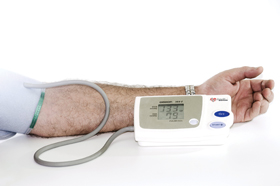Treat metabolic syndrome's many components
Metabolic syndrome's prevalence has rapidly advanced in just the past decade. But medical societies don't recommend treating it as a distinct entity. They'd rather that physicians address the individual components of the illness, and encourage lifestyle modifications as the primary way to achieve such a goal.
Does giving patients an official diagnosis of metabolic syndrome matter as long as an internist treats its components? A 2010 guideline from the American Heart Association (AHA) has added to the controversy over the condition as more Americans head toward obesity, diabetes and cardiovascular problems.
The AHA guideline, which addressed secondary stroke prevention, found no compelling evidence that considering metabolic syndrome changed interventions or outcomes in patients with a history of stroke or transient ischemic attack (TIA). However, it did make a strong recommendation (Class I, Level A) that patients who are diagnosed with the syndrome be treated for those components, all of which are also stroke risk factors, especially high blood pressure and dyslipidemia, to prevent recurrent stroke or TIA.

Regardless of whether metabolic syndrome is diagnosed, internists need to do a better job managing its multiple risk factors simultaneously, said Karen L. Furie, MD, MPH, chair of the guideline's writing committee.
“Our message was that … from a practical point of view it's more important to consider the individual risk factors … [and] to treat all of the components [of metabolic syndrome] aggressively,” she said. The guidelines, which were last updated in 2006, were published in Stroke in October.
Increasing prevalence
The new AHA guideline addressed metabolic syndrome despite finding only one study that examined the association between it and the risk for recurrent stroke, reflecting its potential clinical importance.
“We felt it was a very prevalent concept in cardiovascular literature and one that should be addressed by our group as well, if only to say not a lot is known about this in the setting of secondary stroke prevention,” Dr. Furie said.
A January 2011 article in Diabetes Care reported on data from the National Health and Nutrition Examination Survey (NHANES) showing that 34% of U.S. adults surveyed between 1999 and 2006 had metabolic syndrome, up significantly from 29% in women and 17% in men in studies done from 1988 to 1994.
While 50 million U.S. adults had metabolic syndrome in 1990, 64 million had it in 2000; the authors attributed the increase to growing rates of abdominal obesity and high blood pressure and warned that a subsequent increase in diabetes is expected.
“Metabolic syndrome is of growing prevalence … so physicians need to be aware of it as a condition and try to detect it and intervene as early as possible,” said Ralph Sacco, MD, AHA president and chair of neurology at the University of Miami Miller School of Medicine. It may even overtake smoking as the leading risk factor for heart disease in the future, according to the National Heart Lung and Blood Institute's (NHLBI) Diseases and Conditions Index, updated in January 2010.
Metabolic syndrome is considered to be present when patients meet three of the AHA's five criteria that could indicate increased vascular risk:
- 1. elevated systolic blood pressure of 130 mm Hg or greater or elevated diastolic blood pressure of 85 mm Hg or greater,
- 2. elevated triglycerides of 150 mg/dL (1.7 mmol/L) or greater,
- 3. reduced HDL of less than 40 mg/dL (1.03 mmol/L) in men and less than 50 mg/dL (1.29 mmol/L) in women,
- 4. increased waist circumference of 40 inches (102 cm) or greater in men and 35 inches (88 cm) or greater in women, and
- 5. elevated fasting glucose of 100 mg/dL (5.6 mmol/L) or greater.
While the NHLBI warns that even having one of these factors increases patients' risk of heart disease, a physician whose patient has at least three should take extra time to determine if more screening tests are needed, said Dr. Furie, who is director of the Massachusetts General Hospital Stroke Service in Boston and associate professor of neurology at Harvard Medical School. It also gives physicians a chance to check whether the patient is developing more subtle manifestations of cerebrovascular disease, such as cognitive dysfunction.
Waist circumference alone can be enough to flag a high-risk individual, according to Michael G. Jakoby IV, FACP, associate professor of medicine and medical director of the Center for Diabetes and Metabolic Health at Southern Illinois University School of Medicine in Springfield, Ill.
“I think we should focus more on visceral adiposity as an underlying unifying mechanism than if [the patient] meets three of five criteria,” he said. “There's a relationship between waist and visceral adiposity and stroke and heart disease. It can be a clue.” Larger waist circumference is also associated with higher mortality, according to an article in the Aug. 9/23, 2010 Archives of Internal Medicine.
Waist circumference is critical enough that it should become a routine part of internists' set of vital signs if it isn't already, said George A. Bray Jr., MACP, professor at the Pennington Biomedical Research Center of Louisiana State University in Baton Rouge, La. “It's just as important as weight,” he said.
What's in a name?
Organizations like the American Diabetes Association and the European Association for the Study of Diabetes don't support defining the metabolic syndrome as a true syndrome (a 2005 joint statement is online) , “since there is no special treatment other than the treatment of its individual components and the advantage to the patient is not apparent,” according to Patrick Alguire, FACP, ACP's acting senior vice president for education.
Some experts, including Dr. Jakoby, agree that addressing the risk factors, especially when they're borderline, is more important than what you call them.
“I would argue that there's very little clinical value in making a diagnosis of metabolic syndrome. … There's no specific treatment for the syndrome versus different manifestations,” he said. “In our practice we don't drive home ‘You have metabolic syndrome,’ that it's somehow worse than type 2 diabetes.”
But other experts maintain that raising awareness by using the term can help physicians piece together various symptoms and address them before they lead to a serious illness.
“Sometimes we look at factors in silos,” said Dr. Sacco. “We may monitor blood pressure but say, ‘It's not greater than 140 over 80 so it's not hypertension, so we won't treat it.’ Or we may look at triglycerides but they're not greater than 200, so we don't get concerned.”
Once patients with the metabolic syndrome are identified, physicians can work with those at higher risk to target lifestyle changes, said Dr. Bray, who authored the College's Physicians' Information and Education Resource (PIER) module on obesity, which addresses metabolic syndrome.
That's its value for Louis J. Aronne, FACP, clinical professor of medicine at Weill Cornell Medical College and director of the comprehensive weight control program affiliated with New York Presbyterian Hospital. “Metabolic syndrome is a very important marker for me to help find people who are at risk for whom we can do something,” he said.
In addition, because patients may be hearing more about the syndrome in the lay press, using the term may help dispel misguided views as well as focus on addressing those individual components. That's convinced Mary Ann Bauman, MD, to consider diagnosing metabolic syndrome more often.
“I didn't before because I wasn't sure it would make a difference in what I'm doing,” said Dr. Bauman, medical director for women's health and community relations at Integris Health Inc. in Oklahoma City, and a spokesperson for the AHA's “Go Red for Women” initiative, which focuses on fighting heart disease in women.
Achieving success
Of course, medications such as antihypertensive and antilipid agents play a role in managing metabolic syndrome, but the biggest challenge is how to best discuss lifestyle modifications with patients, a time-consuming and at times frustrating process. Busy physicians are “quick to prescribe medication when somebody has hypertension, but don't spend enough time counseling weight reduction, etc.,” Dr. Sacco said.
Dr. Jakoby focuses on lifestyle change rather than weight loss, coaching patients on changing the behaviors that led to the syndrome and offering support and education from his clinic in terms of dietary interventions, individual and group diabetes education programs, and structured exercise programs. Even a 5% to 10% weight loss can lead to demonstrable health benefits, he noted.
“We're mainly concerned with healthy lifestyle and aerobic and metabolic fitness versus hitting certain weight loss targets,” he said. “If [patients are] eating better and exercising regularly, then weight loss will come over time as a consequence.”
He suggested that internists become familiar with resources in their communities that could help their patients with metabolic syndrome, including registered dieticians, diabetes centers, and local gyms.
Dr. Bauman makes a point of discussing lifestyle changes with patients at each visit, combining standard vital signs procedures, such as measuring waist circumference, with direct talk.
When patients say they don't know why they gained 10 pounds and aren't exercising, “I say, ‘I know why,’” she said. But instead of just admonishing patients to lose weight, she tells them bluntly, “You're playing with fire. You have multiple risk factors and have run out of time to say ‘I'll do this next year.’ You've lost your ability to say ‘This won't happen to me.’ You must start to concentrate on this now.”
When patients counter that they feel fine, she tells them their condition “is doing damage whether you feel great or not.”
She discusses exercise at every visit even when patients come in for another reason.
“I say, ‘We have to talk about this,’” she said. She offers strict recommendations such as exercising at least 20 to 30 uninterrupted minutes three times a week, keeping an exercise log, and eating out less often. She also reminds patients that exercise has to be something they do all the time, no “treats or breaks or excuses.”
While her persistent strategy doesn't work for every patient, those who follow through and get positive results find additional reward in her response.
“I'm their greatest cheerleader. I do a lot of congratulating and give praise because I know it's hard,” she said. “And the patient will say, ‘I was waiting for that.’”
In the end, making progress with patients who have metabolic syndrome may be a matter of setting the right goals and finding the right perspective. “It depends on your definition of success,” Dr. Jakoby said. “We try to set realistic targets on a patient-by-patient basis.”
He gets the best results, he noted, by supporting patients rather than lecturing them, yet making expectations clear.
“I find all patients need is a little encouragement to start and some direction and they end up changing their lifestyle for the better,” he said.





